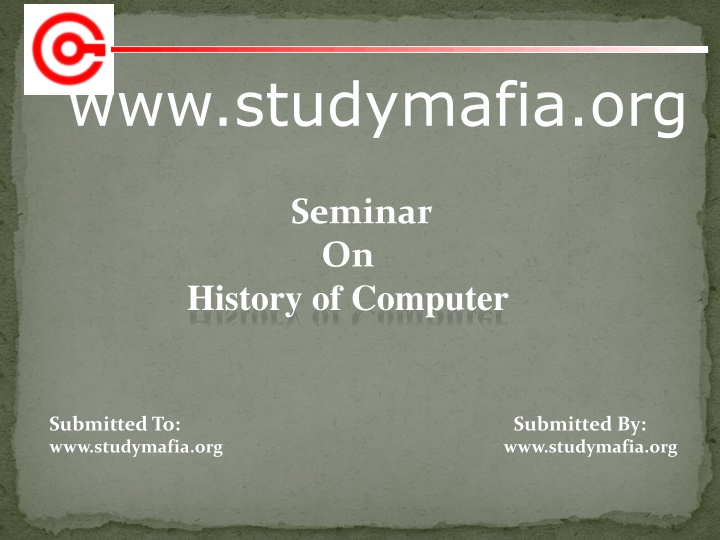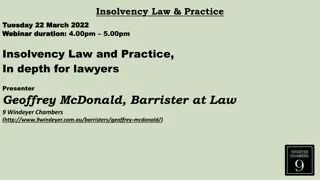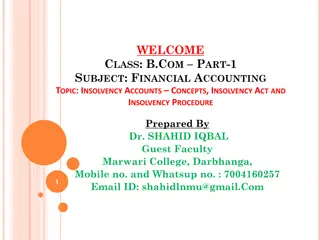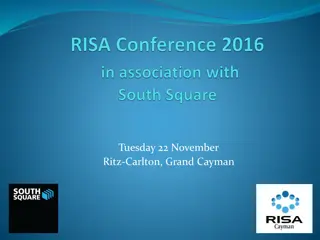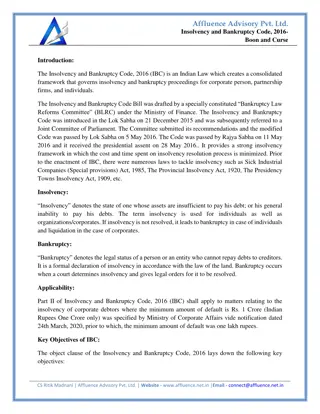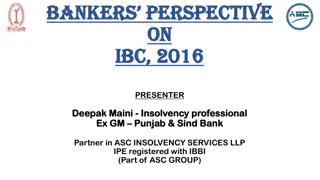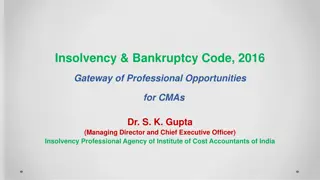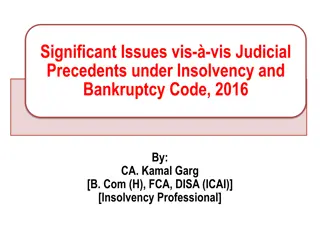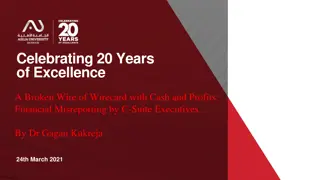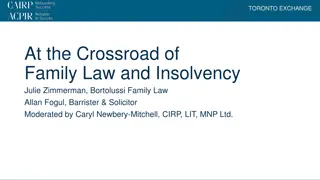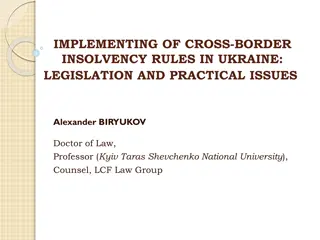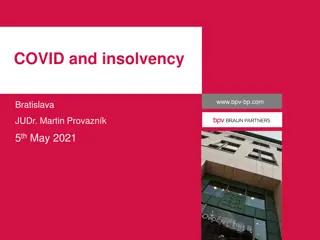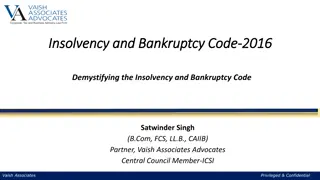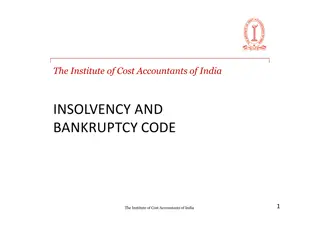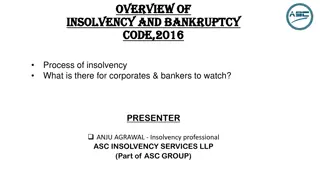Challenges and Remedies in Corporate Insolvency Resolution Process
Delays in admission applications, lack of reliable information, adherence to timelines, third-party security definition, preferential transactions, and handling diversified businesses are discussed in the context of practical challenges and remedies in the pre and post-insolvency resolution process.
Uploaded on Apr 21, 2025 | 0 Views
Download Presentation

Please find below an Image/Link to download the presentation.
The content on the website is provided AS IS for your information and personal use only. It may not be sold, licensed, or shared on other websites without obtaining consent from the author.If you encounter any issues during the download, it is possible that the publisher has removed the file from their server.
You are allowed to download the files provided on this website for personal or commercial use, subject to the condition that they are used lawfully. All files are the property of their respective owners.
The content on the website is provided AS IS for your information and personal use only. It may not be sold, licensed, or shared on other websites without obtaining consent from the author.
E N D
Presentation Transcript
www.studymafia.org Seminar On History of Computer Submitted To: www.studymafia.org Submitted By: www.studymafia.org
Content Definition of a Computer Definition of Modern Computer Abacus Napier Bones Side rule Pascaline Stepped Reckoner Jacquard Loom Arithmometer Difference Engine and Analytical Engine
Definition of a Computer The first counting device started to be used by the primitive people. These are the sticks and stones. As technology improves and human minds develop more and more computing devices are invented and developed. The first computer is really the people. Computer then was a job title. Computer was used to describe human beings especially women whose job is to perform repetitive calculations required to compute such things as navigation tables, tide charts, and planetary positions for almanacs.
Definition of a Computer Information Processor Input and Output
Definition of Modern Computer Inputs, outputs, processes and stores information Physical: Keyboard, monitor, etc. are these necessary components?
A typical computer operation back when computers were people
ABACUS Abacus is an ancient instrument used in performing arithmetic calculations. It can do add, subtract, multiply and divide. It consists of tablet or frame bearing parallel wires or grooves in which the counters or beads are moved. For a skilled user of abacus he could perform addition and subtraction in the same speed with the person using an electronic computer. However, multiplication and division are much slower. It is not in China that abacus was really invented . The oldest surviving abacus was used 300 B.C by the Babylonians. Until now, China, Japan and Korea are still using the abacus.
A modern abacus. Abacus is just a representation of the human fingers: the 5 lower rings in each rod represent the 5 fingers and the upper rings represent the 2 hands.
NAPIERS BONES Invented by a Scottish named John Napier . He first invented the logarithms in 1617 and he got the idea from printed tables. From the printed tables he made an alternative wherein logarithms values are carved on ivory sticks .
SLIDE RULE A slide rule can do very difficult calculations engineers and architects were using it before in calculations. Three men developed the slide rule and they were Edmund Gunter, William Oughtred, and Robert Bissaker. It was in 1632 when slide rule was first built in England. It was used in the 1960s by engineers of Mercury, Gemini and Apollo programs which landed men on moon.
Leonardo da Vinci made had drawn gear-driven calculating machines but had never built any.
SCHICKARDS CALCULATING CLOCK In 1623, German Professor, Wilhelm Schickard built this first gear-driven calculating device. However this device got little publicity for its inventor died because of the outbreak of bubonic plague in the Mediterranen.
PASCALINE At the age of 19, Blaise Pascal invented the Pascaline in 1642 for his father who is a tax collector. He had built 50 of this gear-driven one- function calculator, which only performs addition. But he wasn t able to sell the device because of its high cost and inaccuracy. Pascaline uses complicated arrangement of numbered wheels connected by gears. Pascal continually develop his machine until it can already perform subtraction and addition up to nine digits long.
This is the pascalline opened up with gears and cylinders which rotated to show the numerical result
STEPPED RECKONER Gottfried Wilhelm Von Leibniz is a German mathematician who discovered the fundamental principles in infinitesimal calculus. In 1672, Leibniz invented a calculating machine which he called the stepped reckoner. He called it a stepped reckoner for instead of using gears like Pascal it has fluted drums with ten flutes arranged around their circumference in a stair-step fashion. It is capable of adding, subtracting, multiplying, dividing , and extracting roots. The device uses the decimal number system.
JACQUARDS LOOM In 1801, Joseph-Marie Jacquard , a French inventor developed the power loom. The Jacquard s loom works by using wooden punched cards held together in a rope to program patterns in order to create woven fabrics. The presence or absence of each hole in the card physically allows a colored thread to pass or stop the thread. A close up of a Jacquard punched card
DIFFERENCE ENGINE Charles Babbage designed this steam driven calculating machine about the size of the room. The machine intended to solve tables of numbers, such as logarithm tables which was use in navigations. The difference engine should be capable or calculating 20-decimal capacity of solving mathematical problems. The machine was greatly funded by the British government to be used by the Navy. Unfortunately, even though a lot of money was put into the completion of the machine it was never been finished.
This is only a small section of Babbage s difference engine
ANALYTICAL ENGINE Again, Charles Babbage conceived a new machine, called the analytical engine. He got the mechanism of Jacquard s loom. The punched card technology was used in this machine and Babbage improved it. The analytical engine is programmable, it is as large as a house with 6 steam engines. It is capable of performing mathematical calculations, storing information by using punched cards as a permanent memory. This machine also uses conditional statement to perform calculations. Babbage befriended Ada Byron for the fashioning programs of the Analytical engine. However when Ada had already made plans and notes for the machine, Babbage refused to publish his ideas. The British government refused to fund Babbage s machine and remain unbuilt. It was only in 1833 that the machine was constructed but then only a part of it was finished.
LADY ADA AUGUSTA BYRON KING She is the very first computer programmer. A daughter of the famous poet Lord Byron. She became the Countess Lady Lovelace. At the age of 19, she already got interested in Babbage s ideas of the Analytical Engine. Ada and Babbage had communicated through letters and meetings and had studied for the programming of the engine. She wrote a series of notes wherein she detailed sequences of instructions she had prepared for the analytical engine.
HOLLERITHS TABULATING MACHINE Herman Hollerith, an American engineer who invented the Hollerith desk. He used the same idea in Jacquard s loom. The machine consisted of a card reader which sensed the holes in the card, a gear driven mechanism which could count using Pascal s mechanism and a large wall of dial indicators to display the result of the count. Hollerith s invention was used in the 1890 U.S. Census . Hollerith s desk made computational time faster. He developed the Hollerith s Tabulating Machine Company which was later changed in 1924 by the name International Business Machines(IBM).
The Hollerith's desk The operator working with the Hollerith's desk
Holleriths tabulating machine was the very first machine to be on the cover of a magazine
References www.google.com www.wikipedia.com www.studymafia.org Seminarppt.com
